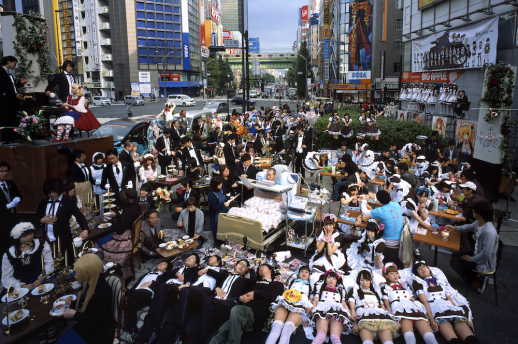10 Things in Tokyo: February Round-Up

Masahiro Usami (his work pictured above) is a photographer who captures all his subject’s various connections with people and objects in their “worlds” in one picture. See his incredible images plus a documentary about his practice from February 13th until 28th.
Kishio Suga is one of Japan’s most celebrated artists and a key member of Mono-ha, an avant-garde group from the late 1960s. His major retrospective currently at the Museum of Contemporary Art Tokyo is a special opportunity for those interested in experiencing his philosophical creations. Using stone, wood and sheet metal, the installations Suga creates within a space consist not merely of the relationship between substances, but also (in the words of the exhibition makers) of the “minute and free relational structure between the space and materials as an object.” Until March 22.
The widely loved Yayoi Kusama has a decades-long print-making practice. Ota Fine Arts will present new printed works with her trademark proliferating motifs until February 21.
Since the 1990s, Pierre Huyghe has been using the structures of film to create works somewhere between fiction and reality and other projects focusing on the nature of modern systems behind art museums, exhibitions, modern architecture, copyrights, and ceremonies. The exhibition at Taro Nasu runs from February 6 until March 7.
James MacNeill Whistler, one of America’s greatest 19th century painters, is on display at the Yokohama Museum of Art with a special focus on his intense love of Japonisme, or the Japanese arts boom of Europe in the 1860s. Through his creation of compositions that did not rely on traditional Western perspective, and his use of subdued gradations of color tones, Whistler proved that Japanese art was more than simply the object of an interest in exotic lands, but rather an essential element in the formation of his own unique arts. Until March 1.
Ikko Narahara is one of the leading photographers of postwar Japan. First published in 1958, his “Domains” focuses on two groups of human beings living in isolation; one in a monastery in Hokkaido and one in a female prison in Wakayama Prefecture. Presenting 87 prints, this exhibition introduces important work from Narahara’s early career that established the photographer’s reputation. Until March 1.
For the conservators and archivists: 2011 the March 11th, 2011 tsunami following the Great East Japan Earthquake caused severe damage to cultural property of the Tohoku area in northeastern Japan. The Tokyo National Museum cooperated with institutions including the Rikuzentakata City Museum and the Iwate Prefectural Museum to restore these damaged cultural properties. This exhibition will share the results of four years of art conservation efforts. Until March 15.
Right now on display in Tokyo are Joseph Banks‘s first drawings of Australian and Polynesian flora. Between the years 1768 and 1771, Banks traveled around the Pacific with Captain James Cook and collected a vast array of native plants, later helping to establish the Royal Botanic Gardens in Kew, England. See 18th century science’s first impressions of the Pacific until March 1.
Last year’s highly popular publication Tadashii Fuck No Tsukaikata (How to Correctly Use “Fuck”) is having its very own exhibition to show off supervising artist Madsaki’s funny and topical pop culture illustrations that accompany each example sentence. Until February 15.
The Japan Media Arts Festival returns this year at the National Art Center Tokyo. The international festival gives prizes in four categories: manga, art, entertainment, and animation. From February 4th until 15th.
Emily Wakeling
Emily Wakeling



